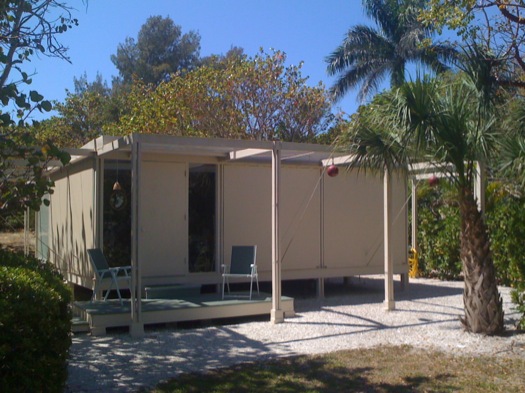
Take a ride down Sanibel Island's West Gulf Drive and you will find, lining its exclusive beachfront, one McMansion after the next, a palisade of Classical, Victorian, and Spanish Colonials with multi-car garages set behind landscaped gates. There is but one exception: Paul Rudolph's Walker Guest House, a simple wood-frame box built in the early 1950s, when Sanibel was a remote island redoubt accessible only by boat, and a stay on its beach occasioned no great ceremony or ostentation.
The beige house, perched on short stilts and tucked in the vegetation, could easily pass for a shed belonging to one of its neighbors. Unlike those behemoths, it is closer to the road than the beach, protected behind a shrub-covered dune. It may not look particularly sturdy in comparison to those much larger houses, but thanks to its judicious siting it has survived a series of destructive hurricanes. In plan it is square, with each side divided into three sections. One of these sections is glazed, the other two have panels that can be raised by a rope-and-counterweight system so that the entire house is open to the elements. When they are up, the panels serve also as a shade-giving lanai. The compact interior design and the pulley system betray Rudolph's wartime experience in the navy.
The obvious precedent for the house is Mies's Farnsworth House, but I'd say it is just as much a progeny of Philip Johnson's Glass House (itself a child of the Farnsworth). Johnson and Rudolph were good friends, close since their days studying architecture at Harvard. Johnson visited Rudolph in Sarasota not long after this house was completed. Like the Glass House, it is classical in its symmetry, with the box-frame forming a kind of diagrammatic, low-end peristyle. The whole thing was built with off-the-rack parts on a tight budget. In this it is the antithesis of the very effete Glass House, but it shares the idea of creating a space open to nature in every direction.
It would be nice if this and other modest vacation houses of the same spirit (Andew Geller's wonderful beach houses come to mind) were a precedent for more of today's clients. On Sanibel, there are unfortunately few examples of the kind of project you'd find in illustrated in a magazine like Dwell. That is to say, relatively modest (to the extent that a vacation house can be), environmentally sensitive homes built with a modern sensibility.
For more on the Walker beach house and Rudolph's other wonderful Sarasota work, Christopher Domin and Joseph King's Paul Rudloph: The Florida Houses is indispensable.

